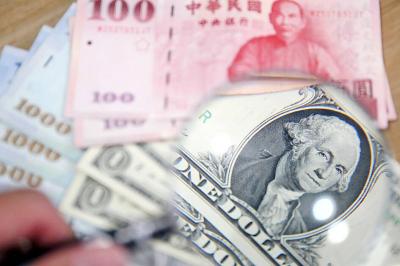The energy industry is taking a relatively conservative approach to boosting output even though profits are booming amid tight supplies of oil and natural gas. If demand remains strong, this production discipline could help sustain high and volatile energy prices at the pump and in the home.
On Friday, oil futures rose to a record high because of the supply tension, while gasoline prices nationwide averaged US$1.90 per gallon. Oil for delivery next month surged US$1.05 to close at US$43.80 a barrel, surpassing the high of US$42.90 set earlier in the week on the New York Mercantile Exchange.
Analysts cite a number of reasons for the industry's cautious approach, including the possibility of a price collapse that would make more aggressive drilling now look foolish later on.
But another plausible explanation is that oil executives -- such as the leaders of the OPEC -- have concluded that it is more profitable to err on the side of underproducing as opposed to overproducing.
"We have not seen the level of capital spending [on exploration and production] reflect the high oil prices or obscene profits," said Fadel Gheit, an equity analyst at Oppenheimer & Co in New York.
"Cynics are saying that maybe, collectively, they have figured out that holding back production is financially beneficial," Gheit added.
It is either that, "or they're really running out of good investment opportunities that would generate good returns in the event that oil prices come down," he said.
But Jim Burkhard, director of global oil at Cambridge Energy Research Associates, said that explanation oversimplifies the situation, particularly by ignoring other market-shaping forces such as geopolitics and consumer demand.
For example, the political strife that exists in oil-producing nations such as Iraq, Venezuela and Nigeria makes it difficult for those nations to maximize their output, constricting worldwide supply growth, Burk-hard said.
Burkhard believes that over the next three to four years there will be substantial supplies added as rising investments in non-OPEC nations such as Russia, Canada and Brazil begin to pay off. But unfortunately for consumers, he added, "there's no tap that companies can turn on to boost production immediately."
Even if they could, oil and natural gas companies would probably hesitate to do so out of fear that an economic slowdown would sap demand or that today's burning geopolitical problems would cool down, taking prices lower just as fast as they went up.
"The price collapses of 1998 and 1999 threw this industry into a deep depression and so in terms of planning for the future you've got to be very cautious," said John Felmy, an economist at the American Petroleum Institute, a Washington-based industry group.
These days, though, profits are soaring. On Friday, oil giant ChevronTexaco Corp reported that profits more than doubled in the second quarter to US$4.13 billion, while independent producer Anadarko Petroleum Corp's second-quarter net income jumped 35 percent to US$405 million.
Capital spending at Houston-based Anadarko fell to US$684 million in the second quarter, down from US$826, while expenditures on exploration and production at ChevronTexaco increased slightly to US$1.6 billion, up from US$1.5 billion.
"Our projects are moving forward at a pace guided by long-term corporate strategy and business plans and not by short-term market conditions," ChevronTexaco spokesman Stan Luckoski said.
Exxon Mobil Corp, the world's largest publicly traded oil company, recently reported that its capital spending fell to US$2.8 billion in the second quarter, down from US$2.9 billion a year ago. Its quarterly profits surged to US$5.8 billion, up from US$4.2 billion last year.
However, Exxon Mobil's annual production has declined for three consecutive years, A.G. Edwards analyst L. Bruce Lanni noted, and it faces the "increasing difficulty of growing production and reserves given the company's massive size and reserve base."
Gheit said he found the industrywide disparity between profits and capital spending "puzzling."
Still, according to an annual survey by Oil & Gas Journal, worldwide exploration and production spending is expected to rise 4.8 percent this year to US$53 billion.
But that doesn't mean oil and natural gas markets will necessarily be awash in new supplies anytime soon. For one thing, oil demand is expected to grow by 3.2 percent this year to 81.4 million barrels a day, according to the International Energy Agency, leaving very little spare production capacity. Analysts estimate there is about 1 million of excess capacity globally, the bulk of it in Saudi Arabia.
The other thing to consider, said Burkhard is that "very large projects take a lot of time to get ready to start up."

The US dollar was trading at NT$29.7 at 10am today on the Taipei Foreign Exchange, as the New Taiwan dollar gained NT$1.364 from the previous close last week. The NT dollar continued to rise today, after surging 3.07 percent on Friday. After opening at NT$30.91, the NT dollar gained more than NT$1 in just 15 minutes, briefly passing the NT$30 mark. Before the US Department of the Treasury's semi-annual currency report came out, expectations that the NT dollar would keep rising were already building. The NT dollar on Friday closed at NT$31.064, up by NT$0.953 — a 3.07 percent single-day gain. Today,

‘SHORT TERM’: The local currency would likely remain strong in the near term, driven by anticipated US trade pressure, capital inflows and expectations of a US Fed rate cut The US dollar is expected to fall below NT$30 in the near term, as traders anticipate increased pressure from Washington for Taiwan to allow the New Taiwan dollar to appreciate, Cathay United Bank (國泰世華銀行) chief economist Lin Chi-chao (林啟超) said. Following a sharp drop in the greenback against the NT dollar on Friday, Lin told the Central News Agency that the local currency is likely to remain strong in the short term, driven in part by market psychology surrounding anticipated US policy pressure. On Friday, the US dollar fell NT$0.953, or 3.07 percent, closing at NT$31.064 — its lowest level since Jan.

The New Taiwan dollar and Taiwanese stocks surged on signs that trade tensions between the world’s top two economies might start easing and as US tech earnings boosted the outlook of the nation’s semiconductor exports. The NT dollar strengthened as much as 3.8 percent versus the US dollar to 30.815, the biggest intraday gain since January 2011, closing at NT$31.064. The benchmark TAIEX jumped 2.73 percent to outperform the region’s equity gauges. Outlook for global trade improved after China said it is assessing possible trade talks with the US, providing a boost for the nation’s currency and shares. As the NT dollar

The Financial Supervisory Commission (FSC) yesterday met with some of the nation’s largest insurance companies as a skyrocketing New Taiwan dollar piles pressure on their hundreds of billions of dollars in US bond investments. The commission has asked some life insurance firms, among the biggest Asian holders of US debt, to discuss how the rapidly strengthening NT dollar has impacted their operations, people familiar with the matter said. The meeting took place as the NT dollar jumped as much as 5 percent yesterday, its biggest intraday gain in more than three decades. The local currency surged as exporters rushed to